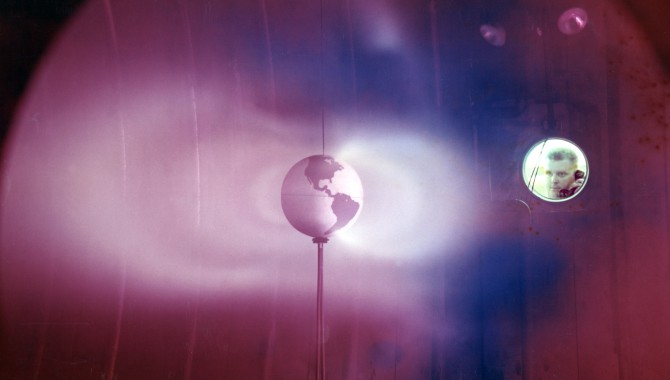
By Matthew Kohut
It’s a story so familiar it has achieved popular status as NASA’s creation legend: when the Soviet Union launched Sputnik in October 1957, it shocked the flat-footed United States into action, locking the Cold War gladiators into a space race. Like most legends, there is a kernel of truth in it, but the full story is more complex. The United States had been working fervently for years to develop its own capability to reach space, most famously through the efforts of Wernher von Braun’s group of rocket scientists at the Army Ballistic Missile Agency. More than two years before Sputnik, the United States had already announced its intention to launch a satellite that would collect scientific data “to benefit scientists from all nations.” The launch would be the centerpiece of the United States’ participation in the first International Geophysical Year (IGY), an oft-overlooked event that helped set the stage for space exploration.
Despite what its name suggests, the IGY was an eighteen-month period from July 1, 1957, through December 31, 1958, during which scientists around the world conducted coordinated observations in eleven earth science disciplines. The IGY began with forty-six participant countries; sixty-seven ultimately became involved. Both Sputnik and Explorer I, the U.S. satellite launch that followed four months later, took place during the IGY. The IGY helped define aims and values that have characterized much of our first fifty years in space: an emphasis on science missions whose results are shared with international communities of scientists. One of the three elements in NASA’s mission statement describes a goal similar to that of the IGY, though grander: “To advance and communicate scientific knowledge and understanding of the earth, the solar system, and the universe.”
The genesis of the IGY has also become something of a legend. It was the inspiration of Lloyd Berkner, an American physicist who worked at the nexus of the scientific and national security communities in a career that seemingly fused Indiana Jones with “The X-Files.” He was an adventurer who accompanied Richard Byrd on his Antarctica expedition in 1928. During World War II, he worked for the U.S. Navy on the development of advanced radar technology. After the war, he became the executive secretary of the Joint Research and Development Board that advised the Department of War and the navy on integrating science and technology into military research and development.

et Propulsion Laboratory Director Dr. James Pickering, Dr. James Van Allen of the State University of Iowa, and Army Ballistic Missile Agency Technical Director Dr. Wernher von Braun triumphantly display a model of the Explorer I, America’s first satellite, shortly after the satellite’s launch on January 31, 1958.
Photo Credit: NASA
In April 1950, Berkner raised the idea of the IGY at a dinner party held by physicist James Van Allen, who worked at the Applied Physics Laboratory at Johns Hopkins University. The British geophysicist Sydney Chapman was also at Van Allen’s that night, and he latched on to Berkner’s suggestion, noting that a period of high solar activity climaxing in 1957–1958 would be an ideal time for observations. All three scientists shared an interest in the potential uses of rockets to expand the reach of atmospheric research.
Berkner suggested the IGY as a broadening of the International Polar Year (IPY), which had been held twice before, in 1882–1883 and 1932–1933. During the first IPY, twelve countries participated in fifteen expeditions to the Arctic and Antarctica. The second IPY focused on the newly discovered “jet stream” and saw participation expand to forty nations. Two years after conceiving the idea at Van Allen’s house, Chapman and Berkner formally proposed the IGY to the International Council of Scientific Unions (ICSU). Once the ICSU approved it, Chapman and Berkner became president and vice president, respectively, of the ICSU’s special committee set up to manage the event. The IGY took place concurrently with the third IPY in 1957–1958.
A U.S. National Committee operating under the guidance of the National Science Foundation coordinated U.S. involvement. The National Science Foundation and the National Academy of Sciences made the case in Washington in favor of developing an Earth satellite, and by July 1955, the White House announced its intent to launch one during the IGY.
On the eve of the IGY’s kickoff, President Dwight D. Eisenhower said that “… the most important result of the International Geophysical Year is the demonstration of the ability of peoples of all nations to work together harmoniously for the common good.”
Eisenhower’s desire for cooperation faced a severe test four months later when the Soviet Union launched Sputnik on October 4, 1957. Within six weeks, the Senate Armed Services Committee, led by the chairman of the Preparedness Investigating Subcommittee, Senator Lyndon B. Johnson, began an “Inquiry into Satellite and Missile Programs.”
On January 31, 1958, two months after the hearings began, Explorer I was launched. Though Sputnik beat the U.S. satellite into space, it returned nothing of scientific value. Explorer I achieved the true goals of the IGY. Through the use of a cosmic ray detector that flew on Explorer I, James Van Allen discovered a radiation belt around Earth, which was later named for him. This has been widely recognized as the greatest scientific contribution of the IGY.

Simulated Van Allen Belts are generated by plasma thruster in Electric Propulsion Laboratory tank # 5 at the Lewis Research Center, now Glenn Research Center. The discovery of the Van Allen Belts has been widely recognized as the greatest scientific contribution of the International Geophysical Year.
Photo Credit: NASA
Despite the competitive dynamic between the superpowers, cooperation remained a key consideration for the United States as it developed its civilian space program. NASA’s first Administrator, T. Keith Glennan, appointed a director of the Office of International Cooperation as part of the new Agency’s management team in October 1958. Within a year, this position went to Arnold Frutkin, who had recently served as deputy to the executive director of the U.S. Committee for the IGY at the National Academy of Sciences. Frutkin’s experience with the IGY directly shaped NASA’s early approach to international cooperation. He went on to write International Cooperation in Space, a seminal work on the topic.
The IGY’s legacy was vast. In addition to the first satellite launches, it resulted in significant scientific gains. Research conducted in Antarctica helped pave the way for ratification of the 1961 Antarctic Treaty. The World Wide Data Centre was established to collect and share atmospheric measurements. Perhaps most importantly, though, the IGY set a precedent for peaceful international scientific collaboration that has been emulated through events such as the International Year of the Quiet Sun of 1964–1965, during which NASA launched Explorer 30 and a number of ship-based sounding rocket experiments. The clearest evidence today of the IGY’s enduring legacy is the fourth International Polar Year, which began in March 2007 and runs through March 2009.









